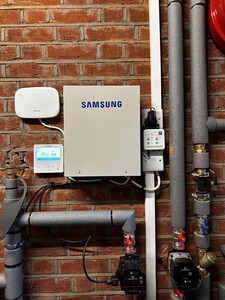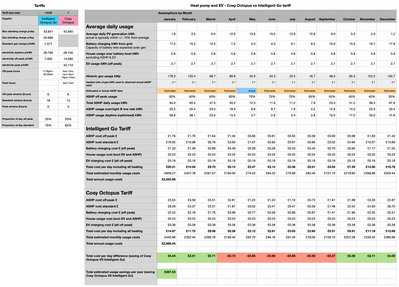Enabling WiFi: Samsung ASHP on Smart Things App
Update: now that the wifi connectivity has been working overnight I can see energy consumption data coming through for the ASHP, which was the main goal. Unfortunately it’s not possible to see data for hours used and generated power through the app. I still have to go to the indoor unit panel to get that.
Current home setup: 12 PV panels on SolarEdge (3.84 kWp), 2 x GivEnergy 9.5kWh batteries, Samsung gen7 R290 16kW ASHP installed May 2025.
Hi, good to hear. To be honest, I've given up with the idea of wifi & remote access. It's all working fine. Once you've got the heat pump set up - the Water Law, as they call plus the basic water temp. I'm leaving it alone. It's off for the summer now.
Unsubscribing
@grahamh-uk thanks for the update. I had considered adding the WiFi module but didn't due to the cost. Like you, I collect the energy used and generated data daily to calculate my daily COP. My unit is in the house so I just take photo's before bed every night, but remote access on the App would be easier. The other (apparent) benefit is that you can remotely turn the DHW / heating on/off, so would be great when returning from holiday to be able to log in before we get home and turn on the DHW so we return to a full tank of hot water.
Samsung 12kW gen6 ASHP with 50L volumiser and all new large radiators. 3.645kWp solar (south facing), Fox ESS inverter.
Solar generation completely offsets ASHP usage annually. We no longer burn ~1600L of kerosene annually.
@old_scientist my installer put in a Homely Energy control box which controls all of the heat pump functions.
The Homely app is good and allows me to easily control hot water and heating schedules and temperature, plus holiday mode if needed. The only thing homely doesn’t allow me to do is get at the historic performance data, hence the need to still use the Samsung Display panel.
The energy usage data on the panel seems to be well organised with the ability to scroll through data by week (broken down to day) and by month. You can scroll back to previous periods using the arrow keys. I’m not sure if you have the same panel as me but if you do it might remove the need for you to take pictures every night.
I use their Homely Smart+ plan (about £25 per year) which optimises the ASHP around our off peak smart tariff periods. That and our battery storage (19kWh + PV 3.87 kWp) means so far the ASHP energy costs are very low. But I haven’t yet experienced a winter with it running.
I’m intrigued that you say in your signature text that you can run all year round from solar. Do you have more details on solar gain by month and ASHP usage?
Current home setup: 12 PV panels on SolarEdge (3.84 kWp), 2 x GivEnergy 9.5kWh batteries, Samsung gen7 R290 16kW ASHP installed May 2025.
Yes, I have the same Samsung controller panel as you. I take photos of the use and generation numbers daily, simply so I can then add these onto my spreadsheet, it's easier than pen and paper, and I'm at an age where I'll forget the two numbers in the time it takes me to walk from the control panel to my PC 🤣
In reference to my signature, I mean my annual solar generation (at around 3800kWh) more than offsets my annual ASHP usage. Of course we generate nowhere near enough in winter to cover our daily usage.
Last winter was our first winter with the ASHP, 3.6kWp of solar and no battery. We used the Octopus Cosy tariff and tried to load shift as much as we could, operating set backs or turning off the heating during peak rate periods. It was not ideal, and the house got pretty cold with the heating off between 4-7pm, and our average import costs were ~19p over winter. With the SCOP we achieved, our running costs were substantially lower than the oil boiler it replaced so we were very happy.
We are currently in the process of trying to add 13.5kW of battery storage (and more solar), which should allow us to operate on Cosy cheap rate, which will reduce our running costs further, and massively improve our usability as no need to turn off or set back, other than for comfort overnight. Doubling our solar to 7.2kWp should allow us to largely cover the ASHP ticking over in winter during the day, even on a cloudy day.
With 19kWh of battery storage available, and a tariff such as Octopus Cosy with 3 cheap rate slots per day, you should have no trouble maximising your savings in winter. After you have usage data from your first winter under your belt, you will be well placed to fine tune your operating strategy to minimise running costs.
We use Cosy for around 6 months of the year (mid October to mid April), and switch away to a more favourable tariff as soon as solar generation/battery capacity can cover our daily usage.
Samsung 12kW gen6 ASHP with 50L volumiser and all new large radiators. 3.645kWp solar (south facing), Fox ESS inverter.
Solar generation completely offsets ASHP usage annually. We no longer burn ~1600L of kerosene annually.
@old_scientist That’s really interesting that you switch between Cosy Octopus in the winter to a more favourable tariff in the summer. Just before having the ASHP installed I modelled the cost difference between the two with theoretical ASHP kWh consumption figures (I used our gas consumption numbers divided by expected COP) and that showed a £300-£400 net advantage for the year in using Cosy Octopus, versus Intelligent Go.
The model showed savings in the winter and extra costs in the summer. How do Octopus react to you changing twice a year? And how long does it take for them to make the transition?
So far, our actual ASHP consumption numbers are higher than I forecast. I think that’s because now we are heating the water for at least 12 hours per day, when previously I was trying to use minimal gas water heating in the warmer months. So I’ve no idea what the actual winter usage will be.
I’d be interested to see your typical consumption if you were willing to share.
You can see my model (and actual ASHP for May, and actual PV gen for all year) here attached. You said you are a spreadsheet person so hopefully this won’t be overwhelming. This model is calculating higher costs on both scenarios than our actual previous costs for gas heating, so I’m hoping the model is wrong and my actual winter ASHP energy usage will be lower.
If you have data to share then it would help me refine my model.
Current home setup: 12 PV panels on SolarEdge (3.84 kWp), 2 x GivEnergy 9.5kWh batteries, Samsung gen7 R290 16kW ASHP installed May 2025.
@grahamh-uk You can switch tariffs with Octopus instantly - I've switched back and fore a couple times between Cosy and Agile, and the switch is instant from the day you accept the offer by email.
Cosy worked well for us last Winter, with solar but no batteries. We shifted as much usage as possible into the three cheap slots. If you have batteries with sufficient capacity to last the 6 hour periods between cheap slots, then you could run totally at the Cosy cheap rate - this is our plan for next winter as we are currently seeking to install 13.5kW of battery. Our peak usage should be around 40-45kWh (hopefully never more than 50kWh) per day. Without batteries, our average import price last winter was ~19p
Without batteries, I've found switching to Agile once the heating season ends has worked out a little cheaper for us. The switchover point is the point where generation exceeds usage, which for us generally coincides when the heating goes off. Once we have the battery installed, IOF (or one of the cheap overnight EV tariffs) will also be a possibility. We use ~10-15kWh per day in summer, so a 13.5kW battery is about right for a days usage in summer.
I'm guessing for you, the moment you can cover your daily usage from battery + generated solar, that's the time to switch to IOG and leverage that 7p/kWh rate rather than the 14p/kWh on Cosy. Of course you only ned to cover 18h of usage as 6h overnight is at cheap rate anyway.
Wow - your DHW usage seems high. We reheat our DHW tank on a schedule, once per day. Do you do likewise, or do you have it on constant reheat? It's a lot more efficient to let it get as cold as possible and then reheat than to constantly top it up (if you have it on constant, try increasing the hysteresis). We heat our tank to around 45C and often it's dropped to around 30C (although still quite warm at the top) before we reheat. One reheat per day does us at present (which uses 1.2 to 1.5kWh), but that may increase as we're in the process of installing a shower which will be fed from the DHW tank to replace our electric shower. We schedule the reheat for early afternoon each day at the warmest part of the day (most efficient) and covered by solar on a sunny day, which gives fresh hot water for the evening meal wash up, and is still plenty hot enough for morning showers before reheating again after lunch.
Samsung 12kW gen6 ASHP with 50L volumiser and all new large radiators. 3.645kWp solar (south facing), Fox ESS inverter.
Solar generation completely offsets ASHP usage annually. We no longer burn ~1600L of kerosene annually.
Hi, interesting about switching tariffs. We are on octopus go & outgoing lite. As we have a phev car - it only takes 7kWh. This means we get 5 hours of cheap rate a night - 8.5p currently. This is great for charging the car & battery overnight. Now it's summer, the CH is off and the water left at 45°. We hardly use any HW - maybe two bowlfuls a day. With a 5.2kW solar and a 13.5kWH battery, it's all working extremely well. We are £53 in credit for the last 28 days! I admit, it has been an unusual sunny couple of months. In peak winter we used £5 a day max on electric which is a big saving on the previous costs. £10/day coal, plus electric and oil! It'll be interesting to see how a whole year goes
I did use "Gary does solar" from YouTube - he has an excellent calculator for doing what-if sums
Cheers
@old_scientist @profzarkov thanks to you both for the very useful information. It's prompted me to run a series of experiments with the ASHP over the next couple of weeks.
Firstly, some context, we have a larger home - about 300 sq meters, and 6 adults living here (with normally around 3 people home/working all day). So that means lots of hot water usage for sinks and showers (and my wife is a daily bath person).
There's also a lot of regular cooking so oven use + use of washing machine, dishwaster etc. All of this means our average house electricity consumption per day is about 19kW excluding ASHP and EV. Prior to the ASHP install our house was self-sufficient for electricity in summer months (when solar gen was 19kWh or above). A good day for us would be 22 or 23 kWh generated.
Our insulation level and air pressure test came back pretty good. But given the size of the house, the heat loss calculation indicated we needed a larger ASHP, hence the 16kW unit. Whatever the ASHP unit uses has to be pulled from the grid, even on the sunniest days. I am thinking of putting in another 7 PV panels, but that's another project.
But as I said, I am surprised that I'm using so much power for the ASHP this month, about 12kWh per day. Part of that is the chilly nights we've had recently. I've set a target heating temperature of 19.5 degrees from 7:30am to 10:30pm and the ASHP has been firing up heating during the night and in the evening to maintain that temperature.
As part of the experiments I'm now running, I've turned off all heating as of this morning (but leaving the 7am to 7pm 45 degree DHW schedule as is). I'll see over the next week how much energy is required just for DHW on that topping up 12 hour schedule. I'll then start segmenting the DHW heating to be morning (needed by my family house mates) plus a top up at a more active solar hour, and maybe an evening top up after 7pm, and see how that goes for energy usage and perception of water temperature.
Another challenge I have on the DHW is whilst I can create a nice hot 290L tank of water, it can cool faster due to longer pipe lengths for the secondary return pumped loop, to reach all taps and bathrooms over 3 floors. Unfortunately when the house was completely renovated 12 years ago, the builders didn't lag the internal hot water pipes. So they radiate heat out in the house and return cooler water back to the tank. I've found a way to reduce the number of hours that the secondary return pump operates by using a Hive smart plug timer plus sensor activation when people are moving into bathrooms, but nevertheless I think the chances of me keeping a piping hot tank of water for hours are low.
I might not get down to the levels of DHW energy efficiency you both have, but I should be able to improve on current usage. Thanks again.
Current home setup: 12 PV panels on SolarEdge (3.84 kWp), 2 x GivEnergy 9.5kWh batteries, Samsung gen7 R290 16kW ASHP installed May 2025.
Posted by: @old_scientistWow - your DHW usage seems high. We reheat our DHW tank on a schedule, once per day. Do you do likewise, or do you have it on constant reheat?
I tried letting the cylinder heating do as it needed, without scheduling and the electric consumption when super high. I now schedule twice a day which became a happy medium of cylinder hot and not upsetting the wife if was ever less than hot.
Posted by: @grahamh-uksecondary return pumped loop
I would switch it off and see if anyone noticed. We used to have ours on morning and evening, it now on just mornings. Only one that noticed was me. But by the time I have undressed for the shower it's just about up to temperature, the water has to go about 20m from cylinder to shower.
Posted by: @grahamh-ukBut as I said, I am surprised that I'm using so much power for the ASHP this month, about 12kWh per day.
Maybe the insulation level isn't as good as you think?
We used 5kWh including a cylinder heat, the rest went into cooling the floor.
Thanks for the input. I've been running various experiments over the last few days with the Homely settings to see how to reduce energy usage.
Firstly, I disabled the heating on the 23rd May. All was fine after turning it off, and all areas of our house remained above 20 degrees at all times (even with the outside temperatures dipping to 9 and 11 degrees during those 3 days). The previous 8 days (with heating enabled) had an average ASHP usage of 13.0 kWh, and with heating off (no other changes) it dropped to 9.1 kWh (-30%).
Over the next few days I've played with keeping the DHW session on continuously between 7am and 7pm, and segmenting it into 3 or 4 sessions. I've also tried turning off Ready-for-set-point and Reheat-during-set-point. I tried raising the temperature to 50 degrees with fewer heating sessions, and no Reheat-during-set-point, but at times with a bath and couple of showers the water started to get too far from target temp.
Right now for us, 6 people, lots of DHW usage the optimal settings seem to be:
- 3 sessions per day (8-10:30am, 12:30-3pm, 7-8pm)
- temp reduced to 46 degrees
- Ready-for-set-point OFF
- Reheat-during-set-point ON
- Preheat-during-off-peak ON
This has brought average daily usage down to about 6.5 kWh (a further 30% drop), although I'll need to run for a few more days with variable weather to be sure.
Current home setup: 12 PV panels on SolarEdge (3.84 kWp), 2 x GivEnergy 9.5kWh batteries, Samsung gen7 R290 16kW ASHP installed May 2025.
- 22 Forums
- 2,090 Topics
- 46.1 K Posts
- 21 Online
- 3,383 Members
Join Us!
Trusted Installers
Struggling to find a reliable heat pump installer? A poor installation can lead to inefficiencies and high running costs. We now connect homeowners with top-rated installers who deliver quality work and excellent service.
✅ Verified, trusted & experienced installers
✅ Nationwide coverage expanding
✅ Special offers available
Latest Posts
-

RE: Adding battery storage to SolarEdge PV system
First things first, thanks to Transparent for sanity ch...
By Majordennisbloodnok , 2 hours ago
-
RE: Surface mount or bury primaries for heat pump installation?
What about those pipes that include conduits for electr...
By tomasmcguinness , 3 hours ago
-
RE: Say hello and introduce yourself
Welcome You have already done the most important thin...
By JamesPa , 3 hours ago
-

RE: Weather compensated secondary circuits with Biomass
If anyone’s going to know the answer to this it’s @sune...
By Mars , 6 hours ago
-
RE: Commencing on an ASHP Installation Process
That outside pipework would concern me. Surely rigid se...
By benson , 17 hours ago
-

As I have reported elsewhere we turned on the cooling o...
By downfield , 20 hours ago
-

-
@el3b Hi, sorry to hear that, it is advisable to instal...
By ASHP-BOBBA , 2 days ago
-
RE: Difficult positioning of air source heat pump
@rikiarn Out of intrigue, the thread reads as though Ai...
By Sheriff Fatman , 2 days ago
-
RE: Mitsubishi Ecodan Fails to Heat Water despite temperature drop
@m1kegibson If you are able to access the service me...
By HarriUp , 2 days ago
-
RE: When will heat pumps and install prices come down?
... which of course is impossible because the world mov...
By JamesPa , 2 days ago
-
My advice is reject unless they will delete the buffer ...
By JamesPa , 3 days ago
-

RE: Battery storage to run Heat Pump.
I would be surprised if the battery chemistry is going ...
By Transparent , 3 days ago
-
RE: Air source heat pump roll call – what heat pump brand and model do you have?
@dowallydrifter OK. I would recommend you read t...
By JamesPa , 4 days ago
-
RE: Solar to power Heat Pump for DHW
Wow, how big is your heat pump that it is pulling 6kW d...
By Old_Scientist , 4 days ago







